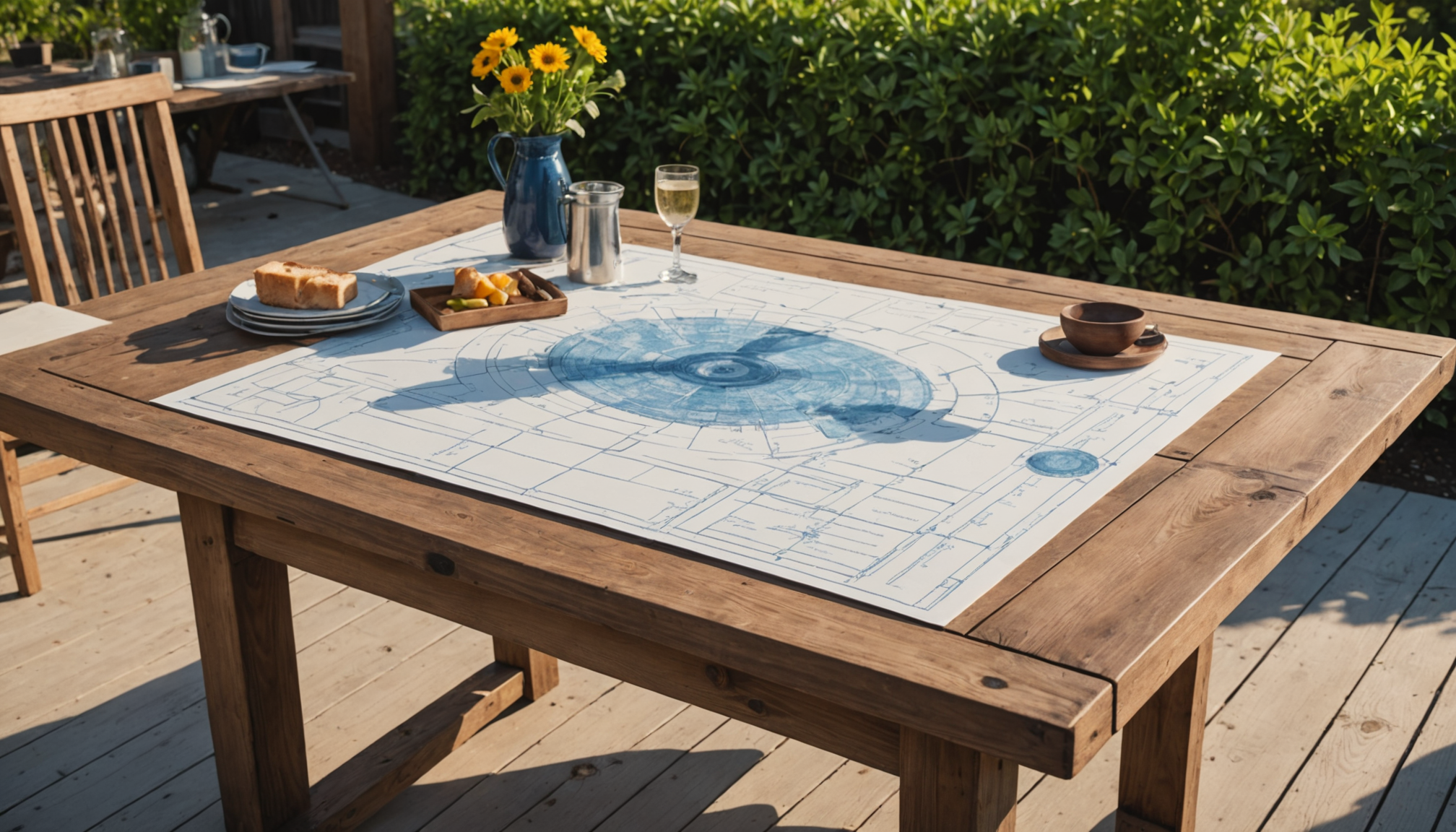Embarking on a patio renovation project can be an exciting endeavor, but it’s crucial to begin with a thorough assessment of your existing space. Evaluating your patio’s current condition and identifying potential improvements will lay the foundation for a successful transformation. Whether you aim to create a modern oasis or simply want to enhance functionality, a detailed assessment will guide your decisions throughout the renovation process.
Start by measuring the dimensions of your patio. Understanding the exact size is fundamental to planning how to maximize the area and design a layout that suits your lifestyle and needs. Accurate measurements will also help you estimate costs and avoid purchasing excess materials.
Next, take note of the current state of your patio. Carefully inspect for any visible damage or areas that may require significant repairs, such as cracked pavement, loose stones, or deteriorating wood. If there are structural issues, addressing them early on will prevent further complications and increase the longevity of your renovation.
Understanding how you currently use your patio space—and how you hope to use it post-renovation—should influence your renovation choices. Consider activities your family enjoys, such as outdoor dining, lounging, or entertaining. This will help you prioritize features when planning your layout and choosing materials and furniture.
Budget planning is also a critical aspect of assessing your patio space. Allocate funds based on the size, scope, and desired quality of your renovation. Keeping an eye on current home improvement trends can provide inspiration and guidance, but remember to tailor your choices to your specific preferences and budget constraints.
| Aspect | Considerations |
| Size | Measure dimensions; plan layout based on space. |
| Condition | Check for damages; repair structural issues. |
| Usage | Determine how the space is used and desired activities. |
| Budget | Consider quality vs. cost; align with current patio trends. |
Analyzing these factors will provide a clear understanding of the scope of your project and set the stage for informed decision-making. Balancing practicality with aesthetics is essential in achieving a patio that is not only modern and stylish but also serves your needs effectively. Comprehensive assessment is the keystone of any successful patio renovation, creating a harmonious extension of your living space that you will enjoy for years to come.
choosing the right materials
When it comes to choosing the right materials for your patio renovation, making informed decisions is key to ensuring both functionality and style. Your selections will impact the overall appearance, durability, and maintenance of your outdoor space. The following steps provide a comprehensive guide to help you navigate this crucial part of your project:
1. Consider Climate and Weather Conditions:
Your local climate significantly influences the materials you should choose.
– For areas with high rainfall, opt for moisture-resistant materials like concrete or treated wood to prevent water damage.
– If you live in a region with extreme temperature fluctuations, select materials like composite decking or high-quality stone that can withstand expansion and contraction without cracking.
2. Evaluate Aesthetic Preferences:
The visual appeal of your patio reflects your personal style and complements your home’s architecture.
– For a modern look, consider sleek materials such as polished concrete or large format tiles.
– For a more rustic or traditional ambiance, natural stone or brick pavers can add character and warmth to the space.
3. Assess Durability and Cost:
Balancing durability with budget is crucial in ensuring longevity and cost-effectiveness.
– Concrete is durable and relatively affordable, suitable for minimalist or modern designs.
– Natural stone offers unmatched beauty and strength, but it comes at a higher price point.
4. Incorporate Safety Features:
Safety should be a priority, especially in areas prone to rainfall or where children and elderly people are present.
– Choose non-slip surfaces like textured stone or textured composite boards to prevent accidents.
– Light-colored materials can remain cooler underfoot in sunny conditions, reducing the risk of burns or discomfort.
5. Research Latest Trends in Materials:
Keeping up with home improvement and patio trends can inspire innovative material choices.
– Eco-friendly options like reclaimed wood or sustainable composite materials are gaining popularity for their minimal environmental impact.
– Permeable pavers are a stylish and sustainable option that allows water to drain through, reducing runoff and improving drainage.
6. Test Maintenance Requirements:
Understanding the upkeep each material demands will help in maintaining your patio’s look and functionality with ease.
– Low-maintenance options such as composite decking or treated concrete are ideal for a busy lifestyle.
– Materials like wood may require regular sealing or staining, so weigh these tasks against your willingness to perform upkeep.
By considering these factors, you’ll ensure that the materials you select not only suit your budget and style but also stand the test of time. Remember, the right materials are a cornerstone of a successful patio renovation, helping create a harmonious extension of your home that stays beautiful for years to come.
selecting furniture and decor
When it comes to accentuating your patio, selecting the right furniture and decor is an essential step in transforming your outdoor space into a functional and inviting area. This process not only involves choosing pieces that align with your personal taste but also ensuring that they cater to the specific needs and layout of your patio.
Start with considering the overall style you wish to achieve. If a modern aesthetic appeals to you, look for furniture with clean lines and minimalist designs, which can create a sleek and contemporary atmosphere. Alternatively, if you prefer a more rustic or traditional vibe, opt for wooden or wicker pieces that bring warmth and an organic feel to your patio. The key is to maintain a consistent style that complements the existing architecture of your home—whether it be modern, vintage, or eclectic.
Prioritizing comfort is equally important. Select furniture pieces that not only look good but also provide ample comfort for you and your guests. Consider cushioned seating options, ensuring that the fabrics are weather-resistant to withstand the outdoor environment. Ottoman and lounge chairs can encourage relaxation, while a spacious dining table can accommodate lively gatherings, transforming your patio into a versatile venue for everything from quiet afternoons to social evenings.
Incorporating functional decor can significantly enhance the usability of your patio. Items like umbrellas or pergolas can provide necessary shade, allowing you to enjoy your patio even during sunny days. Portable heaters or fire pits extend your use of the patio into cooler seasons. Adding stylish storage solutions, such as benches with hidden compartments or decorative trunks, help keep your space tidy, maintaining a polished look.
The finishing touches lie in the details of decor. Selecting outdoor rugs adds texture and color, defining different areas of your patio. Planters, lanterns, and decorative accessories enhance the overall aesthetic and introduce personality to the setting. Consider using decor items that echo the trends in home improvement, such as eco-friendly features that incorporate natural elements or vintage-inspired pieces that add an air of nostalgia.
Ultimately, selecting the perfect furniture and decor involves a careful balance between aesthetic preferences, practical needs, and the unique characteristics of your patio space. By doing so, you will create a cohesive, comfortable, and stylish outdoor oasis that truly feels like a natural extension of your home.
incorporating greenery and lighting
Transforming your patio into a vibrant oasis requires careful consideration of greenery and lighting, both of which contribute significantly to the ambiance and functionality of the area. Integrating plants and light features can elevate your outdoor space from a simple extension of your home to a captivating retreat.
Infusing greenery into your patio can bring life and freshness to the space. Consider using a variety of plants that thrive in your local climate and match the overall aesthetic you aim to achieve. For a modern and streamlined look, use sleek planters filled with ornamental grasses, succulents, or bamboo. If you prefer a more eclectic or rustic vibe, assorted pots with flowering plants or vines cascading down walls can add a touch of charm and character. Incorporating vertical gardens or using wall-mounted planters is an excellent way to maximize limited space and create a lush, green backdrop.
Lighting, a pivotal element in patio design, dramatically impacts the mood and usability of your outdoor area. Begin by assessing the functional needs—adequate lighting near seating and dining areas ensures the space remains usable after dusk. Hanging string lights can create a cozy and inviting atmosphere, their warm glow perfect for evenings spent outdoors. Solar-powered lights are a sustainable option, aligning with the current home improvement trends towards eco-friendly solutions. Path lights or step lights can enhance safety while adding subtle illumination to your layout.
For a more dramatic effect, consider installing statement lighting features such as pendant lights over a dining table or a chandelier in a pergola. These create focal points and can define particular zones within your patio. Use adjustable fixtures or dimmers to manage brightness levels and tailor the ambiance to fit different occasions, from casual gatherings to formal dinners.
Additionally, blending natural elements with modern technology offers innovative ways to illuminate your space. Smart lighting systems allow you to control lighting settings via a smartphone app, giving you the power to adjust tones, colors, and timings to suit your mood or event.
As you integrate these elements, think creatively about how they interact with each other and the broader design of your patio. The right combination of greenery and lighting not only enhances your patio’s aesthetic appeal but also provides a practical update that increases the value and enjoyment of your outdoor living space, all while seamlessly connecting it with the trends you’re aiming to achieve in your renovation project.
planning for maintenance and durability
To ensure your renovated patio remains as stunning and functional as the moment it was completed, planning for maintenance and durability is essential. This stage of your patio renovation involves a strategic approach, ensuring your investment stands the test of time while minimizing long-term upkeep efforts.
Begin by considering the characteristics of each material chosen during the construction phase. Materials like concrete and treated wood often require minimal maintenance, but regular checks are necessary to identify early signs of wear or damage. With concrete, this could mean occasional resealing or filling small cracks, which can extend the life of the surface significantly. For treated wood, maintaining its finish with periodic sealing can prevent moisture damage and preserve its appearance.
Your patio’s exposure to different weather conditions also plays a critical role in its durability. Developing a seasonal maintenance schedule can help counteract the effects of extreme weather. In regions with cold winters, protect your patio by removing snow promptly to prevent the surface from becoming slippery or, in the case of wood, absorbing excess moisture. Conversely, in hot, arid areas, regularly watering surrounding plants will not only keep them healthy but can also help in cooling down the ambient area, reducing heat impact on the surface materials.
Furniture and decor similarly benefit from proactive maintenance. Opt for weather-resistant materials such as metal, resin, or treated woods that resist decay and maintain their look with little effort. Cushioned outdoor furniture should ideally have removable, washable covers that are resistant to fading and mildew. Regular cleaning and storing items during adverse weather conditions can prolong their lifespan.
Incorporating low-maintenance plants such as succulents or native flora into your greenery plan can minimize the time and resources spent on plant care. These options are not only adaptable to various climates but also align with sustainable home improvement trends. Automated watering systems, like drip irrigation, can additionally reduce maintenance while ensuring your plants thrive.
Consider technological advancements that aid in maintenance efficiency. Smart irrigation controllers and weather-responsive lighting systems not only keep maintenance in check but also add to the modern appeal of your patio, consistent with current trends in home innovation.
Ultimately, the longevity and ease of maintaining your renovated patio rely on decisions made during planning and material selection phases. Regular inspections and a well-thought-out maintenance routine will preserve your outdoor space’s charm and functionality, allowing you to enjoy it for many years. Balancing style, function, and easy maintenance ensures that your patio continues to be a valuable extension of your home—a place where form meets practicality seamlessly in your backyard oasis.
In conclusion, renovating your patio requires a thoughtful balance between aesthetics and practicality, ensuring it is tailored to your personal tastes while meeting the demands of daily use and environmental exposure. By beginning with a careful assessment of the space, selecting durable materials, and choosing comfortable, stylish furniture and decor, you can craft an outdoor area that is both functional and inviting. Incorporating elements such as greenery and lighting not only enhances visual appeal but also ensures continuity with the natural surroundings. Finally, by planning for maintenance and durability from the outset, you ensure that your renovated patio remains a cherished space that adapts to trends and endures through seasons, providing a lasting retreat right at home.


